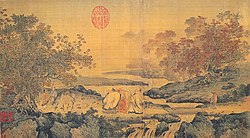Three teachings



In Chinese philosophy, the three teachings (Chinese: 三教; pinyin: sān jiào; Vietnamese: tam giáo, Chữ Hán: 三教) are Confucianism, Taoism, and Buddhism. The learning and the understanding of the three teachings are traditionally considered to be a harmonious aggregate within Chinese culture.[1] Literary references to the "three teachings" by prominent Chinese scholars date back to the 6th century.[1] The term may also refer to a non-religious philosophical grounds of aggregation as exemplified within traditional Chinese medicine.
Three teachings harmonious as one
The phrase also appears as the three teachings harmonious as one (三教合一; San Jiao He Yi). In common understanding, three teachings harmonious as one simply reflects the long history, mutual influence, and (at times) complementary teachings of the three belief systems.[2]
It can also be used in reference to the "
While Confucianism was the ideology of the law, the institutions and the ruling class, Taoism was the worldview of the radical intellectuals and it was also compatible with the spiritual beliefs of the peasants and the artisans. The two, although opposite ends of the philosophical spectrum, jointly created the Chinese "image of the world".[4]
The joint worship of the three teachings can be found in some Chinese temples, such as in Hanging Temple.
Sanjiao believers think that "[t]hree teachings are...safer than one" and that using elements from all three brings good fortune.[5]
Confucianism
The following quotation is from the Analects, a compilation of Confucius' sayings and teachings, written after his death by his disciples.
"The superior man has a dignified ease without pride. The mean man has pride without a dignified ease."
— Confucius, The Analects of Confucius[8]
This quotation exemplifies Confucius' idea of the junzi (君子) or gentleman. Originally this expression referred to "the son of a ruler", but Confucius redefined this concept to mean behaviour (in terms of ethics and values such as loyalty and righteousness) instead of mere social status.[6]
Taoism
The basis of
The following is a quote from the
"The truth is not always beautiful, nor beautiful words the truth."
— Laozi, Daodejing[10]
Buddhism

Another concept prominent in the Buddhist belief system is the Eight-Fold Path. The Noble Eightfold Path is the fourth of the Four Noble Truths, which is said to be the first of all Buddha's teachings.[11] It stresses areas in life that can be explored and practice, such as right speech and right intention.[12]
Controversy
Though the term "three teachings" is often focused on how well Confucianism, Buddhism, and Taoism have been able to coexist in harmony throughout Chinese history, evidence has shown that each practice has dominated, or risen to favour, during certain periods of time.[13] Emperors would choose to follow one specific system and the others were discriminated against, or tolerated at most. An example of this would be the Song dynasty, in which both Buddhism and Taoism became less popular. Neo-Confucianism (which had re-emerged during the previous Tang dynasty) was followed as the dominant philosophy.[14] A minority also claims that the phrase "three teachings" proposes that these mutually exclusive and fundamentally incomparable teachings are equal. This is a contested point of view as others stress that it is not so. Confucianism focuses on societal rules and moral values, whereas Taoism advocates simplicity and living happily while in tune with nature. On the other hand, Buddhism reiterates the ideas of suffering, impermanence of material items, and reincarnation while stressing the idea of reaching salvation beyond.[1]
See also
- Buddhist ethics
- Neo-Confucianism
- Vinegar tasters – story about the leaders of the three teachings
- Three laughs at Tiger Brook
- Shinbutsu-shūgō (merger of Buddhism and Shinto)
- Caodaism (new religion based on the same three)
References
- ^ a b c "Living in the Chinese Cosmos: Understanding Religion in Late-Imperial China". afe.easia.columbia.edu.
- S2CID 54444540.
- ^ Kirkland, Russell. "Lin Zhaoen (Lin Chao-en: 1517-1598)" (PDF). Retrieved 16 February 2011.
- ^ Freiberg, J.W. “THE DIALECTIC OF CONFUCIANISM AND TAOISM IN ANCIENT CHINA.” Dialectical Anthropology 2, no. 3 (1977): 175–98. http://www.jstor.org/stable/29789901.
- ISBN 978-0-395-35336-3.
- ^ a b c d Craig, Albert. The Heritage of Chinese Civilization. Pearson.
- ^ "Confucianism". Patheos. Retrieved 11 February 2015.
- ^ "The Analects Quotes". Retrieved 12 February 2015.
- ^ a b c Chiu, Lisa. "Daoism in China". Retrieved 13 February 2015.
- ^ "Tao Te Ching Quotes". Retrieved 13 February 2015.
- ^ Allan, John. "The Eight-Fold Path". Retrieved 13 February 2015.
- ^ Nourie, Dana. "What is the Eightfold Path?". Retrieved 13 February 2015.
- ^ "San Jiao / San Chiao / Three Teachings". Retrieved 10 February 2015.
- ^ Theobald, Ulrich. "Chinese History - Song Dynasty 宋 (960-1279) literature, thought and philosophy". Retrieved 13 February 2015.
